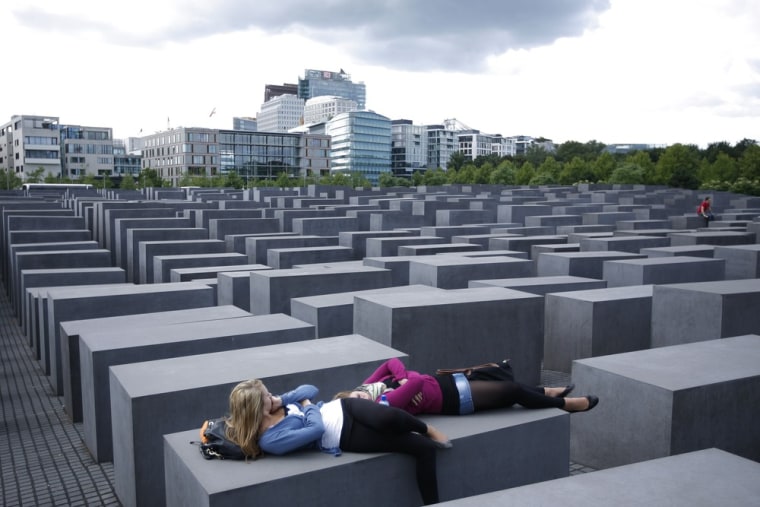Berlin has long been a rarity among the great cities of Europe: exciting, freewheeling, beautiful — and cheap.
Now, as Germany prepares to mark 20 years since east and west were reunited as one, Berlin is finally undergoing the boom that lawmakers had envisioned when they tapped it as the nation's capital in 1991 — and that is causing worries that its "poor but sexy" image is under threat.
Many complain the increase in prosperity is eroding the very Bohemian spirit that has made it attractive, triggering an identity crisis. The students and artists who have long put Berlin at the cutting edge of trends now complain they can no longer afford the skyrocketing rents.
London, Rome and Paris have all gone through the double-edged process of good times sapping their scenes of creative vigor. Now some Berliners fear the same thing is happening to them.
After spending the 1990s ranked with the lowest gross domestic output of Germany's major cities, according to the DIW economic institute, Berlin has recorded the strongest economic growth for the past five years. A population decline has been reversed and a record 4.2 million tourists flocked here in the first six months of 2010, making it the third most popular city in Europe, after Paris and London.
"Berlin is moving and there is everything here: culture, nature, architecture, history, lifestyle — everyone can find their niche here," said Johanna Ebert, 34, manager of the newly opened Hotel4youth, situated on a strip of the land where for six decades the Berlin Wall stood.
The capital — which doubles as a city and a state — reported a more than 1.6 percent jump in overall economic output for 2004 to 2009, according to figures gathered by the DIW. That compares to a national average of barely 0.5 percent.
Changing neighborhoods
Yet there are concerns that the long-sought increase of wealth threatens those elements that have helped make the city exceptional: its chaotic feel, spontaneous clubs and abundance of open spaces and affordable rents that have nurtured a rich experimental art scene.
"Everything is being renovated, money flows in, but the individuality is flowing out," Ebert said.
Indeed, the Prenzlauer Berg neighborhood where the hotel is located has undergone an 80 percent turnover of its original population since 1990. First students and artists drove out the former East German residents, only to see their own rents soar as investors bought up the crumbling prewar buildings and turned them into stylish upscale dwellings.
In the central Mitte district, people are up in arms about a threat to evict artists from a 1990s-era commune, Tacheles, and renovate the dilapidated department store they first squatted in, then rented for a nominal fee.
"There is a danger of demolishing without thinking," said Martin Wollenberg, 45, runs the "Berlin on Bike" tour company. He recalled the former East German parliament building that was torn down in 2008 after a lengthy legal battle to try to save it.
Although tourism currently accounts for only 3 percent of Berlin's economy, the DIW credited the increasing number of visitors with helping feed other service industries.
"Tourism in Berlin is booming much stronger than in other German cities," said Karl Brenke, a researcher with the DIW.
'We can't stop the changes'
Yet the capital's unemployment rate remains one of the highest in the nation. Some 12.3 percent of the city's 3.4 million people were out of work in July, as compared with 7.6 percent nationwide.
Experts say many of newly created jobs are going to people moving to the capital, instead of Berlin natives, many of whom have are trained in Germany's more traditional sectors including hard industry and construction. It is therefore in city officials' interest to see more jobs growth in building and renovation.
The classic example of demolishing without thinking was the Berlin Wall itself, the remains of which are now the city's most sought-after tourist attraction, although only a handful of small stretches remain of the original barrier that was torn down in 1989.
The city's main Wall Memorial has seen its visitor numbers double in the past year, even as it scrambled to recreate a stretch of the original border along the Bernauer Street, securing a former East German watchtower from elsewhere in the nation to stand in the replace of an original that was torn down.
"Tourists are searching for an authenticity that is still there," said Wollenberg, a Berlin native.
He said his company's most popular tours include one retracing the path of the wall that divided the city for nearly four decades with another that follows the path of gentrification, leading tourists past a strip of newly built townhouses across the street from a dilapidated school.
"It is difficult that nothing stays as it was, but we can't stop the changes," Wollenberg said.
